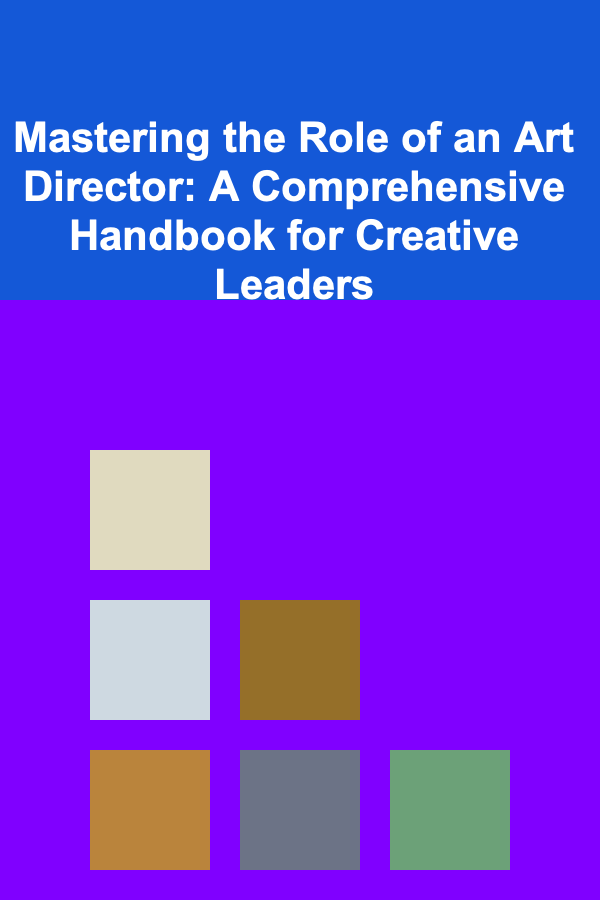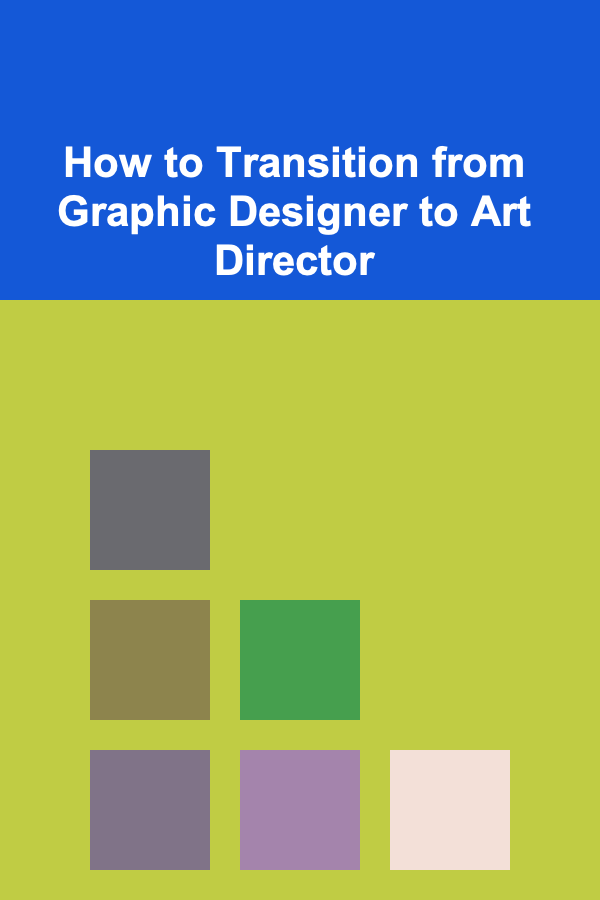
Mastering the Role of an Art Director: A Comprehensive Handbook for Creative Leaders
ebook include PDF & Audio bundle (Micro Guide)
$12.99$5.99
Limited Time Offer! Order within the next:

The role of an art director is one of the most creative and influential positions within the world of design and visual communication. Art directors shape the visual style and tone of projects, ensuring that their aesthetic and conceptual elements are aligned with the client's vision, brand identity, and target audience. Whether in advertising, publishing, digital media, or film, an art director is responsible for overseeing the design process from concept to final product, working closely with teams to bring creative ideas to life.
In this guide, we'll explore the essential skills, responsibilities, and strategies required to excel as an art director. This handbook is designed to offer you actionable insights into how to manage creative teams, make key design decisions, and navigate the dynamic challenges of the art direction field.
The Art Director's Role in Creative Projects
An art director is essentially the visual architect of a project. They are responsible for determining the overall visual style, selecting the appropriate mediums, managing design teams, and collaborating with other stakeholders such as copywriters, photographers, and marketers. Their work is crucial in ensuring that the final product effectively communicates the intended message to the audience.
While the role varies slightly depending on the industry, the core responsibilities of an art director remain the same:
- Conceptualizing Visual Ideas: The art director starts by conceptualizing the creative direction, which includes establishing the visual tone, mood, and overall aesthetic. This phase often involves brainstorming sessions, sketching, and gathering inspiration from various sources to develop an initial concept.
- Collaborating with Creative Teams: Art directors work with a variety of specialists such as graphic designers, illustrators, photographers, and videographers. They must guide these creatives to bring their vision to life while maintaining consistency throughout the project.
- Overseeing Design and Production: Once the creative concept is established, the art director oversees the execution, ensuring that the designs are produced on time, within budget, and meet the desired quality standards. This often involves making revisions and collaborating with clients to refine the visual direction.
- Ensuring Consistency and Brand Identity: A crucial part of the role is maintaining the integrity of the brand or project's visual identity. Art directors must ensure that all design elements align with the brand's core values, aesthetic, and messaging.
Essential Skills for Success as an Art Director
To thrive in the competitive field of art direction, it's essential to hone a wide array of skills. These skills combine artistic vision, leadership, and technical expertise. Here are the most important skills an art director should possess:
1. Creative Vision
An art director must be able to envision the big picture. This requires the ability to generate unique ideas, think conceptually, and adapt to different creative challenges. Whether it's creating a striking advertisement, designing a book cover, or directing a film set, an art director must possess the imagination and foresight to drive a project from an idea to a fully realized visual product.
2. Leadership and Team Management
Art directors oversee teams of designers, illustrators, and other creatives. Being a strong leader involves not only having the vision to guide the project but also the ability to inspire and motivate a team. Effective communication and providing clear feedback are essential for managing creative processes and keeping the team on track.
3. Attention to Detail
The smallest design choices, whether it's typography, color scheme, or layout, can dramatically influence the effectiveness of a visual campaign. Art directors must be meticulous and have an eagle-eyed attention to detail to ensure every design element serves the larger vision.
4. Communication Skills
Art direction is not only about design but also about communicating ideas clearly to clients, team members, and stakeholders. Art directors need to articulate their vision, give constructive feedback, and explain design choices in a way that resonates with both creative and non-creative professionals.
5. Technical Proficiency
A strong understanding of design software is essential for modern art directors. Tools like Adobe Creative Suite (Photoshop, Illustrator, InDesign, etc.) are commonly used to execute ideas. Art directors must also be well-versed in emerging digital design trends, user experience (UX) design, and responsive design for digital platforms.
6. Problem-Solving Skills
Creative challenges are an inevitable part of any project, and an art director must be equipped with problem-solving skills to find innovative solutions. Whether it's a change in direction from the client or a technical limitation, the art director must remain calm and find ways to overcome obstacles while maintaining the integrity of the project.
Navigating the Art Director's Responsibilities
The responsibilities of an art director go far beyond just designing; they involve strategy, collaboration, and adaptation. Let's break down the key areas of responsibility and how an art director can excel in each:
1. Defining the Creative Vision
The first step in any project is to understand the client's goals and objectives. Whether the project is a marketing campaign, a corporate branding initiative, or a multimedia production, the art director must grasp the project's objectives, target audience, and brand guidelines before starting the creative process.
Actionable Tips:
- Have an initial meeting with the client to understand their needs and aspirations.
- Gather inspiration from various sources such as mood boards, art galleries, and competitor analysis.
- Align your creative direction with the overall strategy of the project, considering both artistic and business objectives.
2. Developing and Presenting Ideas
Once the direction is clear, the art director should start developing design concepts. This is often done in the form of sketches, mockups, or mood boards. Art directors need to present their ideas to clients and collaborators and be prepared to defend their design choices, often providing rationale behind color choices, layout, and typography.
Actionable Tips:
- Present multiple design options to clients so they can see different interpretations of the vision.
- Use visual references (mockups, mood boards, etc.) to help clients visualize the concept.
- Be open to feedback but also confident in your creative decisions.
3. Managing the Creative Team
An art director acts as the head of the creative team, ensuring that the design elements align with the overarching vision. This includes managing the workload, providing creative direction to team members, and reviewing work to ensure quality and consistency.
Actionable Tips:
- Break down the project into manageable tasks and delegate them to the appropriate team members.
- Hold regular check-ins with the team to review progress, provide feedback, and address any challenges.
- Encourage collaboration, fostering an environment where team members feel empowered to share ideas and solutions.
4. Maintaining Consistency Across Projects
Consistency is key to a strong visual identity. An art director must ensure that design elements such as typography, color palettes, and branding remain consistent throughout the project, especially if it spans multiple media.
Actionable Tips:
- Create design style guides to document all key elements of the visual identity, ensuring consistency across all platforms.
- Regularly review designs to ensure they align with the brand's established visual identity.
- Conduct quality control checks to verify that all deliverables maintain high standards.
5. Final Execution and Quality Control
Once the designs are ready for production, the art director is responsible for ensuring that the final output meets the highest standards. This can involve overseeing print production, web development, or video editing to ensure the quality is on par with the original vision.
Actionable Tips:
- Work closely with producers, photographers, and printers to ensure technical specifications are met.
- Review proofs, final drafts, or prototypes before approval to ensure the final product meets the vision.
- Ensure all elements are correctly formatted and optimized for the respective media (e.g., web, print, video).
Adapting to the Evolving Industry
The world of design and art direction is constantly changing. As new technologies and platforms emerge, art directors must be adaptable and ready to learn new tools and techniques. Staying ahead of trends and embracing new mediums, such as augmented reality (AR) or virtual reality (VR), can provide a competitive edge.
Continuing Education
To stay relevant, art directors should invest in ongoing education, whether through workshops, online courses, or attending design conferences. Learning about new design software, creative trends, or leadership strategies can further enhance an art director's skills.
Building a Strong Portfolio
A compelling portfolio is essential for any art director. It showcases the range of your creative abilities, your leadership skills, and your ability to handle various types of projects. It should feature a mix of past projects, ranging from branding to web design to advertising campaigns.
Conclusion
Mastering the role of an art director requires more than just creative talent. It demands leadership, vision, technical skill, and a deep understanding of the broader objectives behind every project. By honing the key skills outlined in this guide, you can take on the challenges of art direction with confidence, delivering stunning designs that resonate with audiences and bring creative concepts to life. Through continuous learning, collaboration, and a commitment to excellence, you can excel in this dynamic and rewarding field.
Reading More From Our Other Websites
- [Personal Financial Planning 101] How to Create a Financial Roadmap for Your Dream Vacation
- [Organization Tip 101] How to Store Sensitive Documents Safely
- [Paragliding Tip 101] The Science Behind Paragliding Stalls and How to Avoid Them
- [Organization Tip 101] How to Refresh Your Kitchen Drawer Organization Regularly
- [Home Family Activity 101] How to Transform Your Living Room into a Calming Space for Family Meditation and Relaxation
- [Biking 101] How to Choose the Right Bike Derailleur for Smooth Shifting
- [Home Pet Care 101] How to Select the Best Cat Food Brands for Your Cat's Health
- [Stamp Making Tip 101] Design Secrets: Translating Digital Art into Perfect Stamps
- [Digital Decluttering Tip 101] The Benefits of a Digital Detox: How Less Screen Time Improves Health
- [Toy Making Tip 101] From Cardboard to Playroom: Transform Everyday Materials into Fun Toys

How to Calculate the Return on Investment (ROI) for Influencer Marketing in Dropshipping
Read More
How to Renovate Your Home for Better Storage Solutions
Read More
How to Use Folding Furniture for Flexible Pet Spaces
Read More
Navigating the Complexities of Technology in Consulting: Insights from an IT Consultant
Read More
How to Transition from Graphic Designer to Art Director
Read More
10 Tips for Creating Geometric Tie-Dye Patterns
Read MoreOther Products

How to Calculate the Return on Investment (ROI) for Influencer Marketing in Dropshipping
Read More
How to Renovate Your Home for Better Storage Solutions
Read More
How to Use Folding Furniture for Flexible Pet Spaces
Read More
Navigating the Complexities of Technology in Consulting: Insights from an IT Consultant
Read More
How to Transition from Graphic Designer to Art Director
Read More